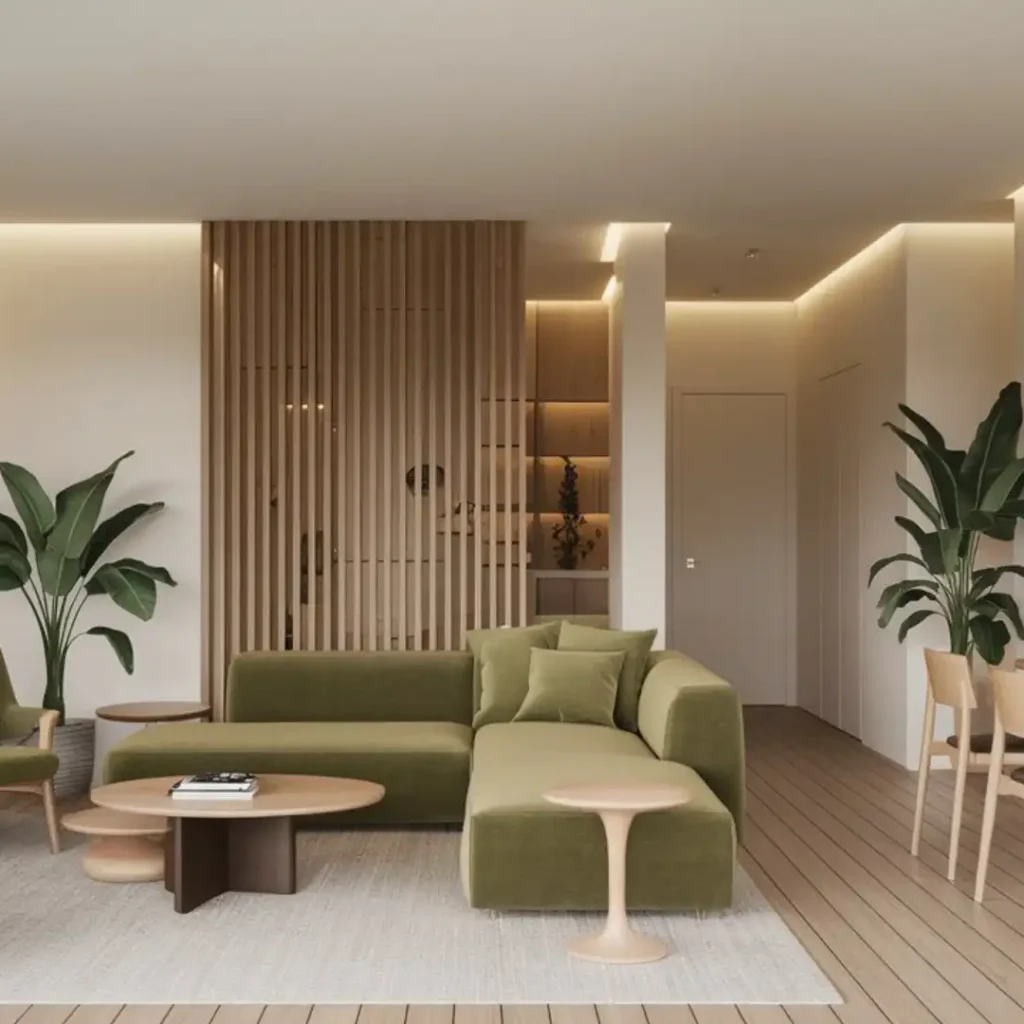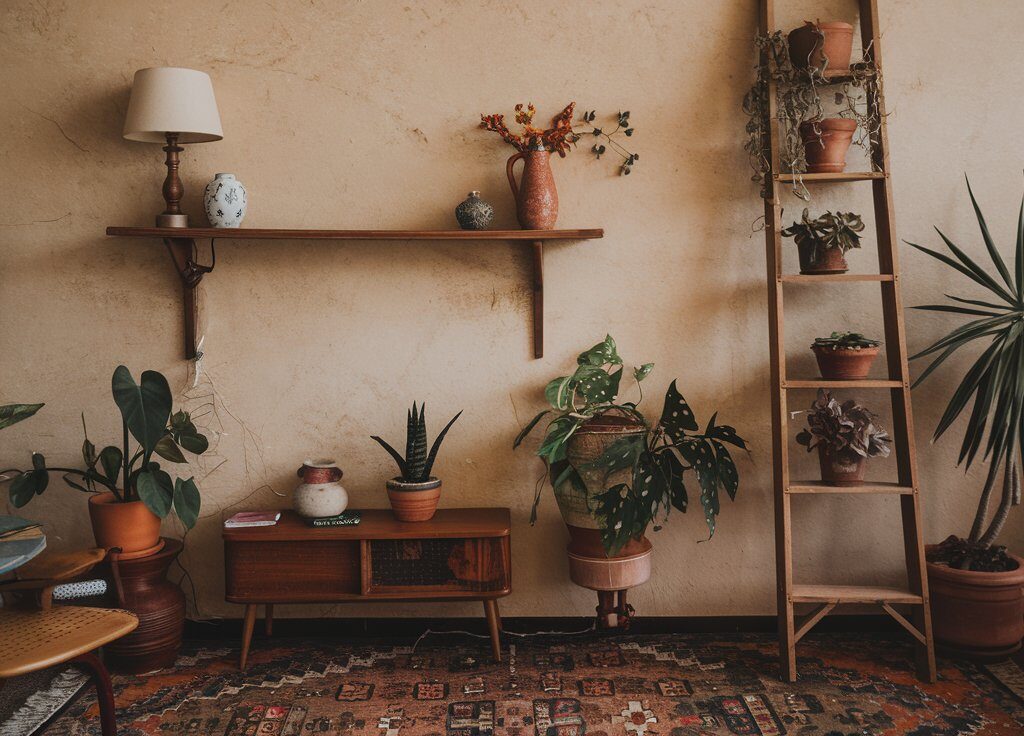



In recent years, modern organic interior design has become a preferred choice for those seeking a harmonious balance between natural elements and contemporary aesthetics. This design philosophy integrates eco-friendly materials, neutral color palettes, and biophilic principles to create soothing, sustainable environments. The rise of this style is a reflection of a growing desire to reconnect with nature in a modern, fast-paced world. Whether you’re transforming your home, office, or any space, the essence of modern organic interior design lies in its ability to foster calm, balance, and a deep connection with nature.
What is Modern Organic Interior Design?
Modern organic interior design is the marriage of sleek, contemporary design with the raw beauty of nature. This style emphasizes the use of natural materials, such as wood, stone, and organic textiles, while maintaining clean lines and uncluttered spaces typical of modern interiors. The goal is to create spaces that are as functional and sophisticated as they are warm and inviting. It’s a response to our increasing need for sustainability and wellness, blending the modern world’s innovation with nature’s calming influence. By emphasizing simple forms, earthy tones, and a natural connection, modern organic interior design creates a peaceful and mindful atmosphere in any space.
Why Modern Organic Interior Design is Trending

Sustainability and Eco-Friendliness
With growing environmental awareness, many homeowners and designers are leaning towards sustainable practices in their interior design choices. Modern organic interior design prioritizes eco-friendly materials, including reclaimed wood, organic fabrics, and energy-efficient lighting. This approach reduces waste, carbon footprints, and reliance on non-renewable resources. Not only is this better for the planet, but it also allows individuals to live in spaces that are healthy and non-toxic. Investing in sustainable products for the home means contributing to a greener future while maintaining a sophisticated, modern aesthetic.
Wellness and Mindful Living
Wellness has become a central focus in how we design our spaces. The calm and natural atmosphere fostered by modern organic interior design directly contributes to mental and physical well-being. Studies have shown that exposure to natural elements, such as plants and natural light, can reduce stress and promote mindfulness. This style’s focus on neutral tones, soft textures, and organic forms creates an environment conducive to relaxation and rejuvenation. As more people prioritize mental health, spaces that reflect tranquility and wellness are increasingly sought after.
Minimalism with a Warm Touch

While minimalism is often associated with stark, cold environments, modern organic interior design offers a warmer, more welcoming take on this style. By incorporating natural textures and earthy tones, this design approach retains the simplicity of minimalism while making spaces feel more inviting. Organic elements like wood, stone, and textiles soften the sharpness of modern lines, creating a balanced and livable aesthetic. The result is a minimalist space that feels warm, approachable, and comfortable, an ideal blend for those seeking both simplicity and a sense of home.
Key Elements of Modern Organic Interior Design
Natural Materials
Natural materials are at the heart of modern organic interior design. Wood, stone, wool, cotton, and leather are commonly used to add texture, warmth, and authenticity to a space. The tactile quality of these materials connects people to nature, offering a break from the synthetic materials often used in other modern design styles. Excellent examples of incorporating natural materials into an interior include furniture made from reclaimed wood, stone countertops, and linen upholstery. These materials not only enhance the aesthetic but also improve the sustainability of the space.
Neutral, Earthy Color Palettes

A hallmark of modern organic interior design is its use of neutral and earthy color palettes. Whites, creams, beiges, soft greys, and natural greens form the foundation of this design’s color scheme. These colors reflect the serenity of the natural world, promoting a sense of calm and balance within the home. By using these muted tones as a base, designers can introduce color through subtle accents such as organic throws, handmade ceramics, or plants—without overwhelming the space. The overall effect is soothing, creating a retreat from the outside world.
Indoor Plants and Biophilic Design

Biophilic design, which emphasizes the connection between humans and nature, is a central component of modern organic interior design. The inclusion of indoor plants brings a breath of fresh air into any space, both literally and figuratively. Whether it’s small succulents, hanging planters, or large potted trees, greenery brings life and movement to a room. Indoor plants not only enhance the organic feel but also help purify the air and boost mental clarity. In addition to plants, the use of natural light is another important feature of biophilic design, helping to create a more dynamic, healthy, and uplifting interior environment.
Minimalism and Functionality
While modern organic interior design is rooted in nature, it also embraces the minimalist principles of modern design. This means clean lines, open spaces, and furniture that serves both functional and aesthetic purposes. Furniture is often simple and unfussy, with an emphasis on durability and practicality. A key goal of this design style is to create a space that is free of clutter, allowing the natural materials and elements to shine. By keeping the decor minimal and thoughtfully chosen, every element has a purpose and contributes to the overall harmony of the space.
Handcrafted and Artisan Pieces

One of the more personalized aspects of modern organic interior design is the use of handcrafted and artisan-made items. These pieces add character, uniqueness, and a sense of authenticity to the space. Whether it’s a hand-woven rug, a hand-thrown ceramic vase, or a custom-made wooden table, these artisanal items elevate the design while supporting craftsmanship and sustainable practices. Each piece tells a story and offers a human connection, aligning with the organic ethos that values imperfections and individuality in design.
Incorporating Modern Organic Interior Design in Different Spaces
Living Room

The living room is a prime area to showcase modern organic interior design. Start by selecting a neutral palette for the walls and larger furniture pieces, such as a linen-covered sofa or natural wood coffee table. Layer in organic textures with wool throws, cotton cushions, and woven baskets to enhance warmth. Large windows or glass doors can help maximize natural light, further connecting the space to the outdoors. Introduce indoor plants like ferns or peace lilies to bring a touch of nature into the room. Minimalistic, functional furniture ensures the space remains uncluttered, with every piece thoughtfully chosen for both form and function.
Bedroom

In the bedroom, modern organic interior design helps create a serene, restful retreat. Focus on natural materials for the bed frame, such as reclaimed wood or bamboo. Opt for soft, organic cotton or linen bedding to enhance the tactile experience. Earthy, muted tones in the walls and textiles foster a sense of calm and relaxation. Indoor plants can be added to the corners or bedside tables, further promoting tranquility. The key is to keep things simple. Avoid too much decoration. Focus on a few special pieces, like a handmade vase or an artisan-carved wooden bench. This will create balance and simplicity.
Kitchen

The kitchen, often the hub of the home, is the perfect space for modern organic interior design. Start by incorporating raw materials, such as stone countertops and wood cabinetry. Consider adding open, reclaimed wood shelves. They can display natural ceramics and wooden utensils, in line with the sustainable ethos. A neutral color palette with warm accents, like brass or copper fixtures, complements the organic elements. Potted herbs on the windowsill not only bring greenery into the space but also serve a practical purpose. The overall aim is to keep the kitchen functional yet aesthetically pleasing, with a focus on sustainable, natural materials.
Home Office

As remote working becomes increasingly popular, the home office is another space where modern organic interior design can enhance productivity and well-being. Start with a solid wood desk, paired with ergonomic seating. Incorporating plants, such as snake plants or succulents, helps purify the air and foster a more peaceful working environment. Natural light is crucial, so place the desk near a window, or use soft, warm lighting to avoid harsh artificial light. Keep the color palette neutral, with organic accents such as a woven basket for storage or a jute rug underfoot. The overall aim is to create a calming, clutter-free environment that supports focus and creativity.
Sustainable Materials in Modern Organic Interior Design

Reclaimed Wood
Reclaimed wood is a key material in modern organic interior design, as it not only looks beautiful but is also highly sustainable. By repurposing old wood, fewer trees need to be cut down, reducing deforestation and waste. Reclaimed wood brings character and history to a space, with its rich textures and imperfections adding a unique element. Reclaimed wood plays a key role in creating a modern organic home, whether it’s used for flooring, furniture, or decorative accents.
Bamboo
Bamboo is another popular sustainable material due to its rapid growth rate and renewability. It’s used for everything from flooring to furniture, providing a sleek yet organic look that fits seamlessly into modern organic interior design. Bamboo is highly durable and versatile, making it an ideal choice for eco-conscious homeowners who want both beauty and sustainability in their interiors.
Cork
Cork is a renewable resource that adds a distinctive texture to interiors. It is often used in flooring or wall applications for its warmth, sound absorption, and sustainability. Cork can be harvested without harming the tree. So, it is eco-friendly. It suits the natural ethos of modern organic design.
Organic Fabrics
Textiles like cotton, linen, wool, and jute are commonly used in modern organic interior design. These materials are not only biodegradable but also typically sourced from sustainable farming practices. Organic fabrics make interiors soft and textured. They work well for upholstery, bedding, and window treatments. Their natural, unprocessed look perfectly aligns with the style’s overall aesthetic.

Modern Organic Interior Design in Different Cultures
Modern organic interior design is a global trend. But, it is uniquely interpreted across cultures. It blends local aesthetics and traditions with modern, nature-inspired designs. By combining traditional organic materials with modern design, this style becomes adaptable and versatile, making it relatable to different cultures.
Scandinavian Influence

One of the most well-known influences in modern organic interior design is Scandinavian design. The Nordic aesthetic has long embraced simplicity, natural light, and minimalism, making it a perfect foundation for the modern organic style. Scandinavian design, like modern organic design, values function. It prefers furniture with clean lines and natural materials, like wood, wool, and leather. Scandinavian homes typically have large windows, light wood floors, and neutral colors. This creates a calm, nature-connected vibe, even in the city. This influence shows that modern organic design can blend function and beauty. It aims to create a cozy, comfortable living space.
Japanese Wabi-Sabi

The Japanese philosophy of wabi-sabi plays a significant role in modern organic interior design by celebrating imperfection and the beauty of natural, raw materials. Wabi-sabi focuses on the idea that beauty can be found in simplicity and imperfection, aligning perfectly with the organic design ethos. In Japanese interiors, you’ll often find natural materials like stone, clay, and weathered wood used in minimalistic yet warm spaces. Allowing materials to age naturally and embracing their imperfections is central to wabi-sabi and modern organic design. These principles are applied to everything from handcrafted furniture to artisanal ceramics, creating spaces that feel serene, lived-in, and connected to nature.
Mediterranean Influence

Mediterranean design also has a notable influence on modern organic interior design, particularly through the use of natural materials like stone, terracotta, and wood. The Mediterranean approach emphasizes indoor-outdoor living, with design elements that bring the outdoors into the home. Mediterranean homes often have terracotta tiles, exposed wooden beams, and plaster walls. These features create a rustic yet sophisticated look that suits modern organic styles. Additionally, the use of natural light and open, airy spaces is a key characteristic of this design, further emphasizing the connection between nature and modern interiors.
Modern Organic Interior Design in Commercial Spaces

While modern organic interior design is often associated with homes, its principles are increasingly being applied to commercial spaces. Offices, restaurants, and shops are using organic materials, natural light, and plants. This creates healthier, more inviting spaces. Biophilic office design boosts employee well-being and productivity. It also increases job satisfaction. Restaurants that use natural wood, stone, and plants create a better dining atmosphere. This design approach benefits customers and employees. It creates spaces that are beautiful and foster wellness and a connection to nature.
How to Personalize Modern Organic Interior Design
Although modern organic interior design has specific principles and characteristics, one of the most appealing aspects of this style is its flexibility and potential for personalization. Here are a few tips on how to make this design style your own.

Incorporate Local Materials
Personalizing a modern organic space can start with the use of local, natural materials that reflect the surrounding environment. In coastal areas, homes might use driftwood and seashells as decorations. In mountainous regions, local stone or wood could be used. This not only supports local artisans and businesses but also makes the space feel more connected to its geographic context.
Personal Art and Handmade Decor
Adding personal touches like family heirlooms, travel souvenirs, or handmade art can give your modern organic interior design a unique and personal feel. Consider adding artwork or sculptures that are meaningful to you, whether it’s a handcrafted pottery piece or a woven wall hanging. These items add a layer of emotional connection and history to the space, making it feel like an extension of your personal story.
Custom Furniture
Another way to personalize your modern organic interior design is through custom-made furniture. Choosing bespoke pieces, whether it’s a dining table crafted from reclaimed wood or a handwoven rug, can make the design feel unique to your home. Custom furniture allows for more creative freedom. It ensures that each piece complements the room’s natural materials and aesthetic.
Future Trends in Modern Organic Interior Design
As design trends continue to evolve, modern organic interior design will likely adapt to new technologies, materials, and philosophies, and expand its scope. Here are a few future trends we can expect to see in this space:

Technological Integration
Although modern organic interior design is centered around nature and simplicity, there is a growing movement to integrate smart technology into these spaces. The challenge is to make sure technology blends in, enhancing the natural look instead of taking away from it. Expect to see more homes with energy-efficient smart lighting, climate control systems, and eco-friendly appliances. They will blend with organic interiors.
Circular Design and Upcycling
Circular design, which reuses materials instead of discarding them, is gaining traction in modern organic interior design. Upcycled furniture and decor turn discarded materials into beautiful, useful pieces. They will likely become more popular. This sustainable practice aligns perfectly with the modern organic ethos, emphasizing longevity, craftsmanship, and reducing waste.
Regenerative Design
Another future trend that ties in with modern organic design is regenerative design. It goes beyond sustainability. It creates spaces that actively give back to the environment. This includes homes that reduce energy consumption, use renewable energy sources, and even produce more energy than they need. Regenerative design means using building materials that restore, not deplete, natural resources. So, interior design should have a minimal impact and even benefit the environment.
Conclusion
As the world shifts to valuing sustainability and wellness, modern organic interior design will shape how we live and interact with our spaces. It will be a powerful force as we seek a closer connection to nature. This design philosophy, which focuses on natural materials, biophilic elements, and mindful minimalism, offers more than just good looks. It provides a way of living that promotes mental well-being, environmental responsibility, and a stronger connection to nature.
From living rooms to kitchens, bedrooms to home offices, modern organic interior design lets us create spaces that are both beautiful and functional, calming and modern. As this style evolves, it will continue to blend the best of modern technology and design with the timeless beauty of the natural world.
Incorporating modern organic interior design into your home or workspace enhances its visual appeal and fosters a sense of balance, mindfulness, and connection to nature. Whether you are drawn to the neutral color palettes, sustainable materials, or the infusion of biophilic elements, this design trend is here to stay. By embracing these principles, you can create spaces that reflect your values and unique style.



